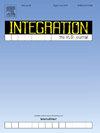Two stage Ordered Escape Routing combined with LP and heuristic algorithm for large scaled PCB
IF 2.2
3区 工程技术
Q3 COMPUTER SCIENCE, HARDWARE & ARCHITECTURE
引用次数: 0
Abstract
The Ordered Escape Routing (OER) problem, which is an NP-hard problem, is critical to PCB design. Primary methods based on integer linear programming (ILP) work well on small-scale PCBs with fewer pins. However, when dealing with large-scale instances, traditional ILP strategies frequently cause time violations as the number of variables increases due to time-consuming preprocessing. In addition, heuristic algorithms have a time advantage when dealing with specific problems. In this paper, We propose an efficient two-stage escape routing method that employs LP for global routing and uses a heuristic algorithm to deal with the path intersection problem to minimize wiring length and runtime for large-scale PCBs. We first model the OER problem as a min-cost multi-commodity flow problem and use ILP to solve it. Then, we relax the non-crossing constraints and transform the ILP model into an LP model to reduce the runtime. we also construct a crossing graph according to the intersection of routing paths and propose a heuristic algorithm to locate congestion quickly. Finally, we reduce the local area capacity and allow global automatic congestion optimization. Compared with the state-of-the-art work, experimental results show that our method can reduce the routing time by 60% and handle larger-scale PCB escape routing problems.
两阶段有序逃逸路由与 LP 和启发式算法相结合,用于大型印刷电路板
有序逃逸路由(OER)问题是一个 NP 难问题,对 PCB 设计至关重要。基于整数线性规划(ILP)的主要方法在引脚较少的小规模 PCB 上运行良好。然而,在处理大规模实例时,由于预处理耗时,随着变量数量的增加,传统的 ILP 策略经常会造成时间违规。此外,启发式算法在处理特定问题时具有时间优势。在本文中,我们提出了一种高效的两阶段逃逸布线方法,该方法采用 LP 进行全局布线,并使用启发式算法处理路径交叉问题,从而最大限度地减少大规模印刷电路板的布线长度和运行时间。我们首先将 OER 问题建模为成本最小的多商品流问题,并使用 ILP 解决该问题。然后,我们放宽了非交叉约束,并将 ILP 模型转化为 LP 模型,以减少运行时间。我们还根据布线路径的交叉点构建了交叉图,并提出了一种启发式算法,以快速定位拥堵位置。最后,我们降低了局部区域容量,实现了全局拥塞自动优化。实验结果表明,与最先进的方法相比,我们的方法能缩短 60% 的路由时间,并能处理更大规模的 PCB 逃逸路由问题。
本文章由计算机程序翻译,如有差异,请以英文原文为准。
求助全文
约1分钟内获得全文
求助全文
来源期刊

Integration-The Vlsi Journal
工程技术-工程:电子与电气
CiteScore
3.80
自引率
5.30%
发文量
107
审稿时长
6 months
期刊介绍:
Integration''s aim is to cover every aspect of the VLSI area, with an emphasis on cross-fertilization between various fields of science, and the design, verification, test and applications of integrated circuits and systems, as well as closely related topics in process and device technologies. Individual issues will feature peer-reviewed tutorials and articles as well as reviews of recent publications. The intended coverage of the journal can be assessed by examining the following (non-exclusive) list of topics:
Specification methods and languages; Analog/Digital Integrated Circuits and Systems; VLSI architectures; Algorithms, methods and tools for modeling, simulation, synthesis and verification of integrated circuits and systems of any complexity; Embedded systems; High-level synthesis for VLSI systems; Logic synthesis and finite automata; Testing, design-for-test and test generation algorithms; Physical design; Formal verification; Algorithms implemented in VLSI systems; Systems engineering; Heterogeneous systems.
 求助内容:
求助内容: 应助结果提醒方式:
应助结果提醒方式:


